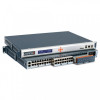Lantronix SLC 8000 Advanced Console Manager User Guide - Page 211
State, Disabled, Dial-in, Dial-out, Dial-back, Dial-on-demand, Use Sites, Group Access
 |
View all Lantronix SLC 8000 Advanced Console Manager manuals
Add to My Manuals
Save this manual to your list of manuals |
Page 211 highlights
9: Device Ports 5. Enter the following fields. State Mode Use Sites Group Access Initialization Script Modem Timeout Caller ID Logging Modem Command Indicates whether the internal modem is enabled. When enabling, set the modem to Disabled, Dial-in, Dial-out, Dial-back, and Dial-on-demand. Disabled by default. The format in which the data flows back and forth. With Text selected, the SLC unit assumes that the modem will be used for remotely logging into the command line. Text mode is only for dialing in. This is the default. PPP establishes an IP-based link over the modem. PPP connections can be used in dial-out mode (e.g., the SLC unit connects to an external network) or dial-in mode (e.g., the external computer connects to the network that the SLC unit is part of), dial-back (dial-in followed by dial-out), CBCP server and CBCP client. When there is an active modem session, the PPP Tx and Rx bytes will be displayed at the top of the window. Enables the use of site-oriented modem parameters which can be activated by various modem-related events (authentication, outbound network traffic for dialon-demand connections, etc.). Sites can be used with the following modem states: dial-in, dial-back, dial-on-demand, dial-in & dial-on-demand, dial-back & dial-on-demand, and CBCP server. For more information see Sites (on page 249). If undefined, any group can access the modem (text login only). If one or more groups are specified (groups are delimited by the characters ',' (comma) or ';' (semicolon)), then any user who logs into the modem must be a member of one of the specified groups, otherwise access will be denied. Users authenticated via RADIUS may have a group (or groups) provided by the RADIUS server via the Filter-Id attribute that overrides the group defined for a user on the SLC unit. A group provided by a remote server must be either a single group or multiple groups delimited by the characters ',' (comma), ';' (semicolon), or '=' (equals) for example "group=group1,group2;" or "group1,group2,group3". Commands sent to configure the modem may have up to 100 characters. Consult your modem's documentation for recommended initialization options. If you do not specify an initialization script, the SLC uses a uses a default initialization string of: AT S7=45 SO=0 L1 V1 X4 &D2 &c1 E1 Q0 Note: We recommend that the modem initialization script always be prepended with AT and include E1 V1 x4 Q0 so that the SLC unit may properly control the modem. Timeout for modem connections. Set to No by default. To configure the modem connection to time out when no traffic is received choose Yes and enter a value of 1 to 9999 seconds. Select to enable the SLC unit to log caller IDs on incoming calls. Disabled by default. Modem AT command used to initiate caller ID logging by the modem. Note: For the AT command, use +VCID=1 to enable Caller ID with formatted presentation, and use +VCID=2 to enable Caller ID with unformatted presentation. This is subject to subscribing to a Caller ID service for the modem line. SLC™ 8000 Advanced Console Manager User Guide 211















